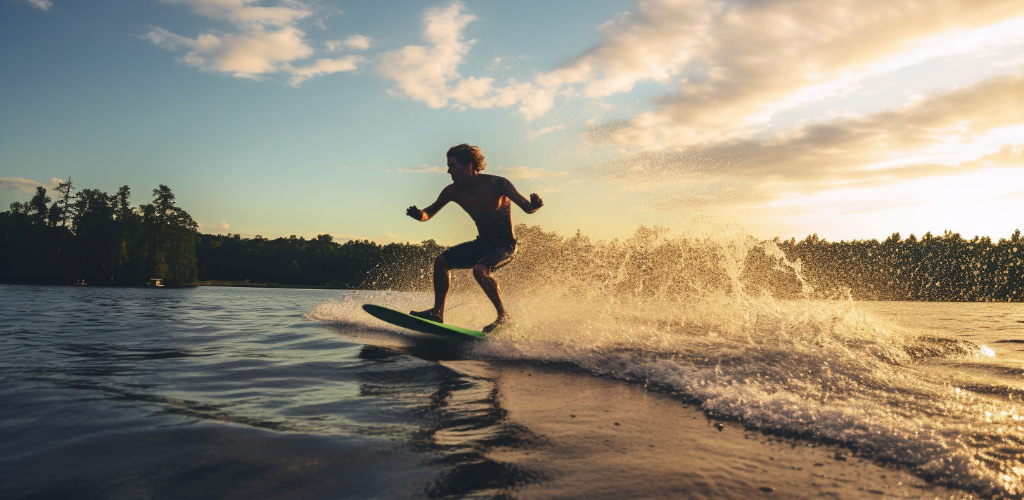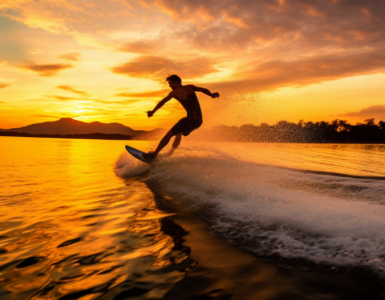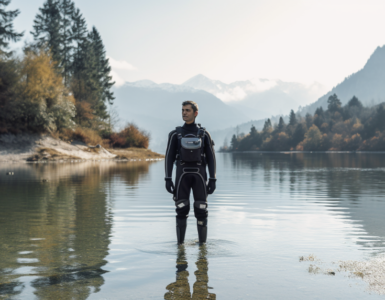Wakeboarding and wakesurfing – two exhilarating water sports that conjure up images of sun-soaked summer afternoons filled with adrenaline and fun. Both have a lot in common – they’re performed on water, they involve a board, and they’re guaranteed to give you a rush. But what separates these two thrilling activities? This blog post aims to dive into the similarities and unique differences between wakeboarding and wakesurfing. So, if you’re unsure about which sport to try out next, or you’re just curious about what sets them apart, read on!
Overview of Wakeboarding
Let’s kick things off with wakeboarding. Originating in the late 1980s as a combination of water skiing, snowboarding, and surfing, wakeboarding involves riding a small, rectangular board over the surface of a body of water. The rider is usually towed behind a motorboat, traversing its wake and executing various jumps and tricks.
The essential equipment for wakeboarding includes a wakeboard, bindings to secure the feet, and a tow rope. The board itself is buoyant, designed with fins and channels that allow for stability and maneuverability. The bindings, attached to the board, provide a secure connection between the rider and the board. The tow rope, connected to the boat, propels the rider across the water.
Overview of Wakesurfing
Next up, we have wakesurfing. Not to be confused with its cousin, wakesurfing is a water sport that, while similar to wakeboarding, has its unique characteristics. Wakesurfing originated in the 1960s and is often seen as the more laid-back alternative to wakeboarding.
In wakesurfing, the rider starts by being towed with a rope but then lets go to ride the boat’s wake freely. The wakesurfing board is longer and more buoyant than a wakeboard, designed to float on the wake without the need for constant towing. This means the rider can surf the wake much like a surfer would ride a wave in the ocean.
Equipment-wise, wakesurfing requires a wakesurfing board and a tow rope. Unlike wakeboarding, bindings are not typically used in wakesurfing. The rope used in wakesurfing is also shorter and thicker, allowing the rider to easily pull themselves into the sweet spot of the wake.
Equipment Differences Between Wakeboarding and Wakesurfing
Have you ever wondered about the gear required for wakeboarding and wakesurfing, and how they differ? Well, let’s dive into it!
Wakeboarding Equipment
Wakeboarding calls for a specific set of equipment. The most crucial piece, of course, is the wakeboard. Wakeboards are typically shorter and broader than a surfboard or a snowboard, allowing for greater maneuverability. They also come with bindings, which are boots attached to the board where the rider secures their feet.
Another crucial piece of equipment is the rope. Wakeboarding ropes are typically non-stretch, providing a consistent pull. Lastly, as with any water sport, protective gear like life jackets and helmets are essential for safety.
Wakesurfing Equipment
On the flip side, let’s talk about wakesurfing equipment. The surfboard used in wakesurfing is the star of the show. Wakesurf boards are generally longer and thicker than wakeboards, allowing for more buoyancy.
As for the rope, wakesurfing ropes are shorter and thicker, providing something sturdy to hold onto while getting up on the wave. Once up and surfing, the rider typically drops the rope and surfs the wave much like ocean surfing. Safety equipment like life jackets is also crucial in wakesurfing.
Learning Curve and Difficulty
So, which of these water sports is generally easier to pick up for beginners? There’s no definitive answer as it can depend on several factors, such as previous board sport experience and individual comfort in the water.
Generally speaking, wakeboarding can be slightly more challenging to pick up initially. This is mainly because it requires a higher speed and the ability to stand sideways on the board, which can be tricky for beginners.
Wakesurfing, on the other hand, is often considered easier to learn. The slower speed and the fact that the rider isn’t attached to the board make the initial learning process less intimidating. However, mastering advanced wakesurfing tricks can take considerable time and practice.
Styles and Tricks
Are you curious about the different styles and tricks that can be performed in wakeboarding and wakesurfing? Well, you’re in for a treat!
Both sports offer a wide variety of tricks and styles that can be performed, each bringing its own level of thrill and excitement. While there are certainly some overlaps, there are also many unique tricks associated with each sport. In wakeboarding, riders can perform jumps, spins, grabs, and even flips! On the other hand, wakesurfers can enjoy maneuvers such as bottom turns, cutbacks, floaters, and even aerials!
It’s worth noting that the tricks performed in each sport are influenced by the equipment used and the wave produced by the boat. For example, the rope used in wakeboarding allows for high-flying aerial tricks, while the free-riding aspect of wakesurfing allows surfers to perform more surf-style maneuvers.
| Wakeboarding Tricks | Wakesurfing Tricks |
|---|---|
| Grabs | Bottom Turns |
| Spins | Cutbacks |
| Jumps | Floaters |
| Flips | Aerials |
Health Benefits
Did you know that wakeboarding and wakesurfing are not just fun, they’re also great for your health? Indeed, both sports provide a full-body workout, improving your strength, balance, and coordination. They also boost cardiovascular health and can help with weight management.
Don’t forget the mental health benefits too! Engaging in these water sports can help reduce stress and improve mood. Plus, the concentration and focus required can also help improve mental clarity and agility.
Safety Concerns
As with any sport, safety is paramount when it comes to wakeboarding and wakesurfing. Both sports, while exhilarating, can pose risks if not approached with caution.
For wakeboarding, potential risks include collisions with the boat or other obstacles, falls at high speed, and injuries from performing tricks. Wakesurfing, on the other hand, carries risks such as falling into the path of the boat, getting tangled in the rope, or colliding with other surfers.
To help mitigate these risks, it’s essential to use the correct protective equipment, including a life jacket and helmet. Additionally, never go wakeboarding or wakesurfing alone and always have a spotter in the boat. Finally, it’s important to know your limits and not push yourself beyond your skill level.
Choosing Between Wakeboarding and Wakesurfing
Have you ever found yourself standing on the shore, looking out at the water, and wondering which water sport to try? The decision between wakeboarding and wakesurfing can be a tricky one. It often comes down to a variety of factors, ranging from your personal preference to your fitness level. Let’s dive into some of the key considerations.
- Experience: If you’ve been involved in similar water sports like surfing or skateboarding, you might find wakeboarding to be more familiar. On the other hand, wakesurfing might be a refreshing new challenge.
- Fitness Level: Both sports require a certain level of physical fitness. If you have a strong core and upper body strength, wakeboarding could be a good fit. Wakesurfing, on the other hand, relies more on balance and leg strength.
- Age: While there’s no age limit to either sport, the physical demands of wakeboarding might be more challenging for older participants. Wakesurfing could be a gentler option.
- Personal Preference: At the end of the day, the best choice is the one you’ll enjoy the most. Do you prefer the thrill of performing tricks and jumps, or the laid-back feel of surfing a wave? Your answer might guide your choice.
Global Popularity
So, which sport is more popular globally, wakeboarding or wakesurfing? While it’s hard to say definitively, various factors such as accessibility of equipment, ease of learning, and spectator enjoyment can influence popularity.
Wakeboarding has been around for longer and has a more established scene globally, which could make it more popular. The sport is also often seen in extreme sports competitions, attracting spectators and participants alike. However, wakesurfing has been gaining ground, especially given its appeal to those who enjoy a more relaxed, surf-style approach to water sports.
Wrapping it Up
Whether you choose wakeboarding or wakesurfing, both sports offer a unique set of challenges and rewards. They require different skills and equipment, but both guarantee an adrenaline rush and a great workout.
Remember, the best way to decide between wakeboarding and wakesurfing is to try them both. After all, why limit yourself to just one when you can enjoy the best of both worlds?




